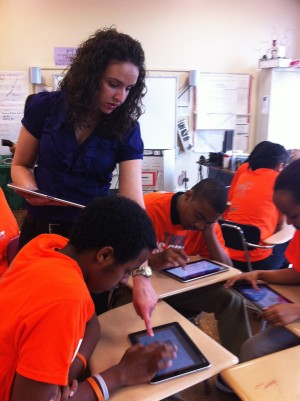Can Wireless Tablets Bridge The Digital and Education Divide?

Elahe Izadi / DCentric
Teacher Bernadette DeSario works with students conducting historical research on wireless tablets.
Coolidge High School students sit in small groups as they prep for their Advanced Placement U.S. history exam. They’ll be expected to write essays on the materials they’ve learned.
“How or why did the anti-slavery movement become more radical during the period between 1815 and 1816?” teacher Bernadette DeSario asks the students during a class last week. ”We’re going to look at a couple of websites that will provide us with primary source documents.”
The students hunch over small, wireless tablets, swiping the screens as they read letters and other 19th century documents, looking for information to support their answers.
Coolidge doesn’t have many computers, principal Thelma Jarrett said. These students get to use tablets provided by Verizon Wireless, through a program running at four D.C. high schools. It’s intended to level the playing field for high school students in low-income schools, particularly as they get ready for college. The program includes tablets that students can use during class, and also a bus converted into a “learning lab,” stocked with tablets, printers and other devices. The bus, which visits the school once a week, is where students go to get help from Howard University tutors in writing college essays and applying to schools.
Coolidge is a Title 1 school, meaning a high percentage of its students come from low-income homes; 64 percent of the student body qualifies for free or reduced lunches. DeSario said many of her students don’t have access to technology, and that the using the tablets helps them develop good, online research skills.
“It’s putting them so far ahead,” she said. “When they get to college, they’re going to be expected to know how to use this technology.”
DeSario has seen increased class participation and better grades from some students after they starting using the tablets. “They’re so much more engaged,” she said.
Senior Lidya Abune said using the tablets has been useful, for both class work and in preparing for college.
“We can access research and we’re exposed to the technology,” she said. ”We didn’t have a lot of chances and opportunities to use the computers. And we have no Internet at home.”
That’s not uncommon in the District, which has a clear digital divide. Many people in low-income neighborhoods are not connected to high speed Internet.
Principal Jarrett said many students go to the library to use computers. She’d like to see the tablet program expand, which can pose an interesting alternative to standard computers. For one, they don’t require much space and they can be cheaper than desktops, she noted. The pilot program, which is at eight schools in D.C. and Maryland, is one that Verizon hopes to eventually expand.
Paying for college?
The Verizon Wireless program may provide some support in helping these students get into college. But there’s still the matter of how to pay for it. The cost of college has gone up dramatically — it’s tripled over the past three decades — and it’s increasingly becoming out-of-reach for the middle class, too.
Abune said she received help in fill out the Free Application for Federal Student Aid and didn’t know a lot about the college application process. Her family “couldn’t afford it, but I really wanted to try and go to a good college.” She’ll be at Bucknell University in the fall on a full scholarship.
Others have applied to scholarships, but are prepared to take on student loan debt, such as senior Zenayda Berrios. She’ll be attending Bennett College, where tuition, room and board comes to about $24,000. The high cost isn’t deterring her from pursuing a degree in psychology, though.
Principal Jarrett said her approach is to not let the cost of college get in the way of students’ ambitions to attend.
“We encourage them to go for college, and then we’ll worry about paying for it,” she said.
She also noted that many students at the school qualify for federal Pell grants, given their income levels. But she acknowledged that many will have to turn to student loans, and “I know that is a last resort.”
Figuring out how to pay for post-secondary schooling will likely become a big issue in the District; a new D.C. measure requires all high school seniors to take a college entrance exam and apply to a college or trade school in order to graduate from high school.
-
E Pluribus Unum





